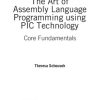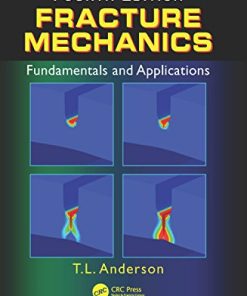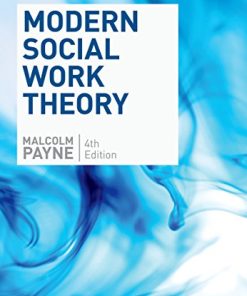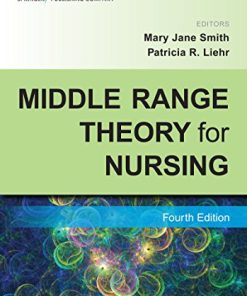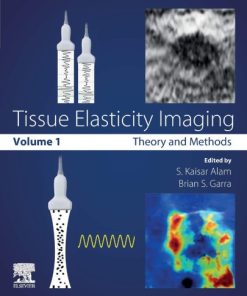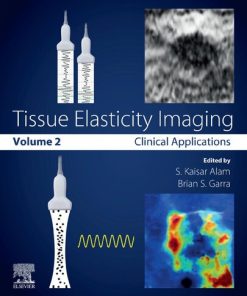(Ebook PDF) Elasticity theory applications and numerics 4th Edition by Martin Sadd 012815988X 9780128159880 full chapters
$50.00 Original price was: $50.00.$25.00Current price is: $25.00.
Elasticity: theory, applications, and numerics 4th Edition by Martin H. Sadd – Ebook PDF Instant Download/DeliveryISBN: 012815988X, 9780128159880
Full download Elasticity: theory, applications, and numerics 4th Edition after payment.
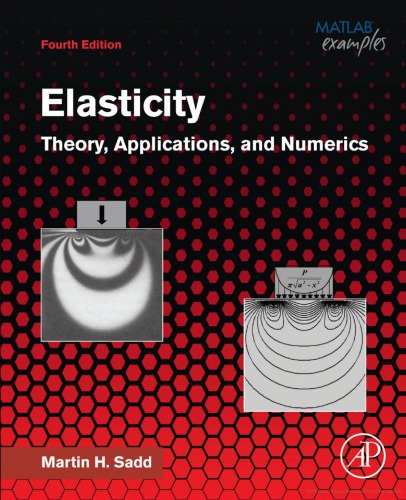
Product details:
ISBN-10 : 012815988X
ISBN-13 : 9780128159880
Author: Martin Sadd
Elasticity: Theory, Applications, and Numerics, Fourth Edition, continues its market-leading tradition of concisely presenting and developing the linear theory of elasticity, moving from solution methodologies, formulations, and strategies into applications of contemporary interest, such as fracture mechanics, anisotropic and composite materials, micromechanics, nonhomogeneous graded materials, and computational methods.
Elasticity: theory, applications, and numerics 4th Table of contents:
1 – Foundations and elementary applications
1 – Mathematical preliminaries
1.1 Scalar, vector, matrix, and tensor definitions
1.2 Index notation
1.3 Kronecker delta and alternating symbol
1.4 Coordinate transformations
1.5 Cartesian tensors
1.6 Principal values and directions for symmetric second-order tensors
1.7 Vector, matrix, and tensor algebra
1.8 Calculus of Cartesian tensors
1.8.1 Divergence or Gauss theorem
1.8.2 Stokes theorem
1.8.3 Green’s theorem in the plane
1.8.4 Zero-value or localization theorem
1.9 Orthogonal curvilinear coordinates
References
1 . Exercises
2 – Deformation: displacements and strains
2.1 General deformations
2.2 Geometric construction of small deformation theory
2.3 Strain transformation
2.4 Principal strains
2.5 Spherical and deviatoric strains
2.6 Strain compatibility
2.7 Curvilinear cylindrical and spherical coordinates
References
2 . Exercises
3 – Stress and equilibrium
3.1 Body and surface forces
3.2 Traction vector and stress tensor
3.3 Stress transformation
3.4 Principal stresses
3.5 Spherical, deviatoric, octahedral, and von Mises stresses
3.6 Stress distributions and contour lines
3.7 Equilibrium equations
3.8 Relations in curvilinear cylindrical and spherical coordinates
References
3 . Exercises
4 – Material behavior—linear elastic solids
4.1 Material characterization
4.2 Linear elastic materials—Hooke’s law
4.3 Physical meaning of elastic moduli
4.3.1 Simple tension
4.3.2 Pure shear
4.3.3 Hydrostatic compression (or tension)
4.4 Thermoelastic constitutive relations
References
4 . Exercises
5 – Formulation and solution strategies
5.1 Review of field equations
5.2 Boundary conditions and fundamental problem classifications
5.3 Stress formulation
5.4 Displacement formulation
5.5 Principle of superposition
5.6 Saint–Venant’s principle
5.7 General solution strategies
5.7.1 Direct method
5.7.2 Inverse method
5.7.3 Semi-inverse method
5.7.4 Analytical solution procedures
Power series method
Fourier method
Integral transform method
Complex variable method
5.7.5 Approximate solution procedures
Ritz method
5.7.6 Numerical solution procedures
Finite difference method
Finite element method
Boundary element method
5.8 Singular elasticity solutions
References
5 . Exercises
6 – Strain energy and related principles
6.1 Strain energy
6.2 Uniqueness of the elasticity boundary-value problem
6.3 Bounds on the elastic constants
6.3.1 Uniaxial tension
6.3.2 Simple shear
6.3.3 Hydrostatic compression
6.4 Related integral theorems
6.4.1 Clapeyron’s theorem
6.4.2 Betti/Rayleigh reciprocal theorem
6.4.3 Integral formulation of elasticity—Somigliana’s identity
6.5 Principle of virtual work
6.6 Principles of minimum potential and complementary energy
6.7 Rayleigh–Ritz method
References
6 . Exercises
7 – Two-dimensional formulation
7.1 Plane strain
7.2 Plane stress
7.3 Generalized plane stress
7.4 Antiplane strain
7.5 Airy stress function
7.6 Polar coordinate formulation
References
7 . Exercises
8 – Two-dimensional problem solution
8.1 Cartesian coordinate solutions using polynomials
8.2 Cartesian coordinate solutions using Fourier methods
8.2.1 Applications involving Fourier series
8.3 General solutions in polar coordinates
8.3.1 General Michell solution
8.3.2 Axisymmetric solution
8.4 Example polar coordinate solutions
8.4.1 Pressurized hole in an infinite medium
8.4.2 Stress-free hole in an infinite medium under equal biaxial loading at infinity
8.4.3 Biaxial and shear loading cases
8.4.4 Quarter-plane example
8.4.5 Half-space examples
8.4.6 Half-space under uniform normal stress over x≤0
8.4.7 Half-space under concentrated surface force system (Flamant problem)
8.4.8 Half-space under a surface concentrated moment
8.4.9 Half-space under uniform normal loading over −a≥x≥a
8.4.10 Notch and crack problems
8.4.11 Pure bending example
8.4.12 Curved cantilever under end loading
8.5 Simple plane contact problems
References
8 . Exercises
9 – Extension, torsion, and flexure of elastic cylinders
9.1 General formulation
9.2 Extension formulation
9.3 Torsion formulation
9.3.1 Stress–stress function formulation
9.3.2 Displacement formulation
9.3.3 Multiply connected cross-sections
9.3.4 Membrane analogy
9.4 Torsion solutions derived from boundary equation
9.5 Torsion solutions using Fourier methods
9.6 Torsion of cylinders with hollow sections
9.7 Torsion of circular shafts of variable diameter
9.8 Flexure formulation
9.9 Flexure problems without twist
References
9 . Exercises
2 – Advanced applications
10 – Complex variable methods
10.1 Review of complex variable theory
10.2 Complex formulation of the plane elasticity problem
10.3 Resultant boundary conditions
10.4 General structure of the complex potentials
10.4.1 Finite simply connected domains
10.4.2 Finite multiply connected domains
10.4.3 Infinite domains
10.5 Circular domain examples
10.6 Plane and half-plane problems
10.7 Applications using the method of conformal mapping
10.8 Applications to fracture mechanics
10.9 Westergaard method for crack analysis
References
10 . Exercises
11 – Anisotropic elasticity
11.1 Basic concepts
11.2 Material symmetry
11.2.1 Plane of symmetry (monoclinic material)
11.2.2 Three perpendicular planes of symmetry (orthotropic material)
11.2.3 Axis of symmetry (transversely isotropic material)
11.2.4 Cubic symmetry
11.2.5 Complete symmetry (isotropic material)
11.3 Restrictions on elastic moduli
11.4 Torsion of a solid possessing a plane of material symmetry
11.4.1 Stress formulation
11.4.2 Displacement formulation
11.4.3 General solution to the governing equation
11.5 Plane deformation problems
11.5.1 Uniform pressure loading case
11.6 Applications to fracture mechanics
11.7 Curvilinear anisotropic problems
11.7.1 Two-dimensional polar-orthotropic problem
11.7.2 Three-dimensional spherical-orthotropic problem
References
11 . Exercises
12 – Thermoelasticity
12.1 Heat conduction and the energy equation
12.2 General uncoupled formulation
12.3 Two-dimensional formulation
12.3.1 Plane strain
12.3.2 Plane stress
12.4 Displacement potential solution
12.5 Stress function formulation
12.6 Polar coordinate formulation
12.7 Radially symmetric problems
12.8 Complex variable methods for plane problems
References
12 . Exercises
13 – Displacement potentials and stress functions: applications to three-dimensional problems
13.1 Helmholtz displacement vector representation
13.2 Lamé’s strain potential
13.3 Galerkin vector representation
13.4 Papkovich–Neuber representation
13.5 Spherical coordinate formulations
13.6 Stress functions
13.6.1 Maxwell stress function representation
13.6.2 Morera stress function representation
References
13 . Exercises
14 – Nonhomogeneous elasticity
14.1 Basic concepts
14.2 Plane problem of a hollow cylindrical domain under uniform pressure
14.3 Rotating disk problem
14.4 Point force on the free surface of a half-space
14.5 Antiplane strain problems
14.6 Torsion problem
References
14 . Exercises
15 – Micromechanics applications
15.1 Dislocation modeling
15.2 Singular stress states
15.3 Elasticity theory with distributed cracks
15.4 Micropolar/couple-stress elasticity
15.4.1 Two-dimensional couple-stress theory
15.5 Elasticity theory with voids
15.6 Doublet mechanics
15.7 Higher gradient elasticity theories
References
15 . Exercises
16 – Numerical finite and boundary element methods
16.1 Basics of the finite element method
16.2 Approximating functions for two-dimensional linear triangular elements
16.3 Virtual work formulation for plane elasticity
16.4 FEM problem application
16.5 FEM code applications
16.6 Boundary element formulation
References
16 Exercises
People also search for Elasticity: theory, applications, and numerics 4th:
elasticity theory applications and numerics solution manual
elasticity theory applications and numerics 4th edition pdf
elasticity theory applications and numerics martin h. sadd
elasticity theory applications and numerics solutions
elasticity theory applications and numerics 4th edition
Tags:
Elasticity,theory,applications,numerics,Martin Sadd
You may also like…
Uncategorized
Fracture Mechanics: Fundamentals and Applications, Fourth Edition 4th Edition – Ebook PDF Version
Science (General)
(Ebook PDF) Tissue Elasticity Imaging 1st edition by Kaisar Alam 9780128096833 full chapters
Science (General)
Tissue Elasticity Imaging: Volume 2: Clinical Applications 1st Edition S. Kaisar Alam (Editor)
Biology and other natural sciences - Human Biology
Multiscale Biomechanics: Theory And Applications 1st Edition Soheil Mohammadi



